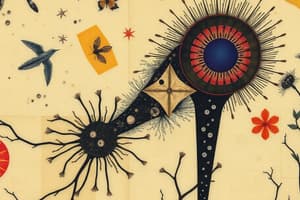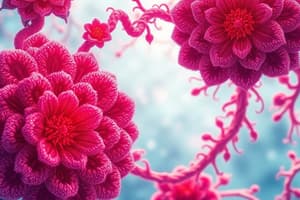Podcast
Questions and Answers
Which of the following best describes the relationship between genes and heredity?
Which of the following best describes the relationship between genes and heredity?
- Heredity controls the expression of genes based on environmental conditions.
- Genes are the mechanism through which traits are inherited, carrying specific DNA sequences that determine characteristics. (correct)
- Genes and heredity are unrelated processes; genes determine cell structure, while heredity governs energy use.
- Heredity is the process by which genes mutate and create new traits in offspring.
How does natural selection contribute to the process of evolution?
How does natural selection contribute to the process of evolution?
- It ensures that all individuals in a population have an equal chance of survival and reproduction.
- It drives evolution by creating new genetic variations within a population.
- It prevents species from adapting to changing environments, ultimately leading to extinction.
- It favors the survival and reproduction of individuals with advantageous traits, leading to gradual changes in the characteristics of a population over time. (correct)
What is the significance of homeostasis in living organisms?
What is the significance of homeostasis in living organisms?
- It eliminates the need for organisms to consume energy.
- It allows organisms to grow indefinitely without any constraints.
- It causes organisms to rapidly adapt to changing environmental conditions.
- It enables organisms to maintain a stable internal environment despite external changes, ensuring optimal conditions for cell function. (correct)
How do organisms obtain and utilize energy, and what role does ATP play in this process?
How do organisms obtain and utilize energy, and what role does ATP play in this process?
A scientist is studying the interactions between different species in a rainforest ecosystem. Which sub-discipline of biology is most relevant to this research?
A scientist is studying the interactions between different species in a rainforest ecosystem. Which sub-discipline of biology is most relevant to this research?
Which of the following scenarios best illustrates the concept of homeostasis?
Which of the following scenarios best illustrates the concept of homeostasis?
A researcher is interested in understanding how a specific gene influences the development of a particular trait in mice. Which biological principle is most directly relevant to this study?
A researcher is interested in understanding how a specific gene influences the development of a particular trait in mice. Which biological principle is most directly relevant to this study?
Which of the following processes involves the conversion of energy into a usable form for cells, such as the production of ATP?
Which of the following processes involves the conversion of energy into a usable form for cells, such as the production of ATP?
Which of the following best illustrates the organization of life from simplest to most complex?
Which of the following best illustrates the organization of life from simplest to most complex?
The evolutionary relationships between all living organisms are best illustrated by:
The evolutionary relationships between all living organisms are best illustrated by:
Which domain includes organisms with membrane-bound organelles?
Which domain includes organisms with membrane-bound organelles?
A scientist is studying the rate of photosynthesis in different species of plants. Which branch of biology is this scientist most likely working in?
A scientist is studying the rate of photosynthesis in different species of plants. Which branch of biology is this scientist most likely working in?
Which of the following fields would be most directly involved in studying the effects of climate change on the distribution of bird species?
Which of the following fields would be most directly involved in studying the effects of climate change on the distribution of bird species?
A researcher discovers a new species of bacteria that thrives in extremely hot environments. Which branch of biology would be most relevant to studying this organism?
A researcher discovers a new species of bacteria that thrives in extremely hot environments. Which branch of biology would be most relevant to studying this organism?
Which activity is NOT typically part of the scientific method?
Which activity is NOT typically part of the scientific method?
A biologist is studying the structure and function of proteins within a cell. Which field of biology is this researcher most likely working in?
A biologist is studying the structure and function of proteins within a cell. Which field of biology is this researcher most likely working in?
Understanding the evolutionary relationships between different species is crucial for:
Understanding the evolutionary relationships between different species is crucial for:
Which application of biology is most directly related to improving crop yields and developing disease-resistant plants?
Which application of biology is most directly related to improving crop yields and developing disease-resistant plants?
Flashcards
Biology
Biology
The scientific study of life, including its structure, function, growth, origin, evolution, and distribution.
Cell Theory
Cell Theory
States that all living organisms are made of cells, the basic units of structure and function, arising from pre-existing cells.
Gene Theory
Gene Theory
States that traits are inherited through genes, specific DNA regions coding for particular traits passed from parents to offspring.
Evolution
Evolution
Signup and view all the flashcards
Natural Selection
Natural Selection
Signup and view all the flashcards
Homeostasis
Homeostasis
Signup and view all the flashcards
Molecular Biology
Molecular Biology
Signup and view all the flashcards
Energy in Biology
Energy in Biology
Signup and view all the flashcards
Molecules
Molecules
Signup and view all the flashcards
Cells
Cells
Signup and view all the flashcards
Tissues
Tissues
Signup and view all the flashcards
Organs
Organs
Signup and view all the flashcards
Organ Systems
Organ Systems
Signup and view all the flashcards
Organisms
Organisms
Signup and view all the flashcards
Bacteria
Bacteria
Signup and view all the flashcards
Anatomy
Anatomy
Signup and view all the flashcards
Physiology
Physiology
Signup and view all the flashcards
Hypothesis
Hypothesis
Signup and view all the flashcards
Study Notes
- Biology is the scientific study of life
- Explores structure, function, growth, origin, evolution, and distribution of living organisms
- Recognizes the cell as the basic unit of life and genes as the basic unit of heredity
- Evolution is the engine that propels the creation and extinction of species.
- Living organisms consume and transform energy and maintain homeostasis to survive
- Sub-disciplines are defined by organism scale, organism type, and study methods
- Molecular biology studies the fundamental chemistry of life
- Cell biology examines the cell as the basic building block of all life
- Physiology examines the physical and chemical functions of tissues, organs, and organ systems
- Ecology examines how organisms interact in their environment
Core Principles of Biology
- Based on unifying principles to explain and predict natural phenomena
Cell Theory
- All living organisms are composed of one or more cells
- The cell is the basic unit of structure and function in organisms
- All cells arise from pre-existing cells through cell division
Gene Theory
- Traits are inherited through genes
- Genes are specific regions of DNA that code for particular traits
- Genes are passed from parents to offspring and determine offspring characteristics
Evolution
- Change in the characteristics of a species over several generations
- Relies on the process of natural selection
- Natural selection is the differential survival and reproduction of individuals due to differences in phenotype.
- Evolutionary biology studies evolutionary relationships between organisms and mechanisms driving evolutionary change.
Homeostasis
- Maintenance of a stable internal environment despite external changes
- Essential for the proper functioning of cells and organisms
- Homeostatic mechanisms include temperature regulation, pH balance, and osmoregulation
Energy
- All living organisms require energy to carry out life processes
- Obtained from the sun (photosynthesis) or chemical compounds (cellular respiration or fermentation)
- Stored as ATP (adenosine triphosphate) and used to power cellular activities
Hierarchical Organization of Life
- Life is organized hierarchically, each level building upon the previous one
- Molecules are groups of atoms held together by chemical bonds
- Cells are the basic units of life, composed of molecules and capable of carrying out life processes
- Tissues are groups of similar cells that perform a specific function
- Organs are structures composed of different tissues working together to perform a specific function
- Organ systems are groups of organs working together to perform a complex function
- Organisms are individual living beings composed of organ systems
- Populations are groups of individuals of the same species in a particular area
- Communities are groups of interacting populations of different species in a particular area
- Ecosystems are communities of organisms interacting with their physical environment
- The biosphere is the sum of all ecosystems on Earth
The Tree of Life
- Illustrates the evolutionary relationships between all living organisms
- Based on molecular biology, paleontology, and comparative anatomy evidence
- Divided into three domains
- Bacteria: single-celled prokaryotic organisms
- Archaea: single-celled prokaryotic organisms more closely related to eukaryotes than bacteria
- Eukarya: eukaryotic organisms, including protists, fungi, plants, and animals
Branches of Biology
Anatomy
- Study of the structure of organisms and their parts
- Includes gross anatomy (structures visible to the naked eye)
- Includes microscopic anatomy (structures visible only with a microscope)
Physiology
- Study of the function of organisms and their parts
- Examines the physical and chemical processes that occur in living organisms
Genetics
- Study of heredity and variation in organisms
- Explores how traits are passed from parents to offspring
- Includes the study of genes, DNA, and the mechanisms of inheritance
Ecology
- Study of the interactions between organisms and their environment
- Examines the distribution and abundance of organisms
- Studies the flow of energy and matter through ecosystems
Botany
- The scientific study of plants
- Encompasses plant physiology, structure, genetics, ecology, distribution, classification, and economic importance
Zoology
- The scientific study of animals
- Includes animal physiology, anatomy, behavior, ecology, evolution, and classification
Microbiology
- Study of microorganisms (bacteria, viruses, fungi, and protozoa)
- Explores their structure, function, genetics, and their roles in disease, industry, and the environment
Molecular Biology
- Studies the molecular basis of biological activity
- Focuses on the structure, function, and interactions of biological macromolecules
- Macromolecules include proteins, nucleic acids, carbohydrates, and lipids
Evolutionary Biology
- Studies the evolutionary processes that have shaped the diversity of life on Earth
- Examines the mechanisms of evolution, such as natural selection, genetic drift, and mutation
- Studies the evolutionary history of organisms and their relationships to one another
Scientific Method in Biology
- Biologists use the scientific method to investigate the natural world
- Involves
- Observation: observing a phenomenon or identifying a problem
- Hypothesis: formulating a testable explanation for the observation
- Experimentation: designing and conducting experiments to test the hypothesis
- Data analysis: analyzing the results of the experiments
- Conclusion: drawing conclusions based on the data and determining whether the hypothesis is supported or rejected
- Communication: sharing the findings with the scientific community through publications and presentations
Importance of Biology
- Essential for addressing many of the challenges facing humanity
- These challenges include
- Human health: understanding disease, developing new treatments, and preventing the spread of infectious diseases
- Environmental conservation: understanding ecosystems, protecting biodiversity, and mitigating the effects of climate change
- Food security: developing new crops, improving agricultural practices, and ensuring a sustainable food supply
- Biotechnology: developing new technologies based on biological principles, such as gene therapy, biofuels, and bioremediation
Studying That Suits You
Use AI to generate personalized quizzes and flashcards to suit your learning preferences.




